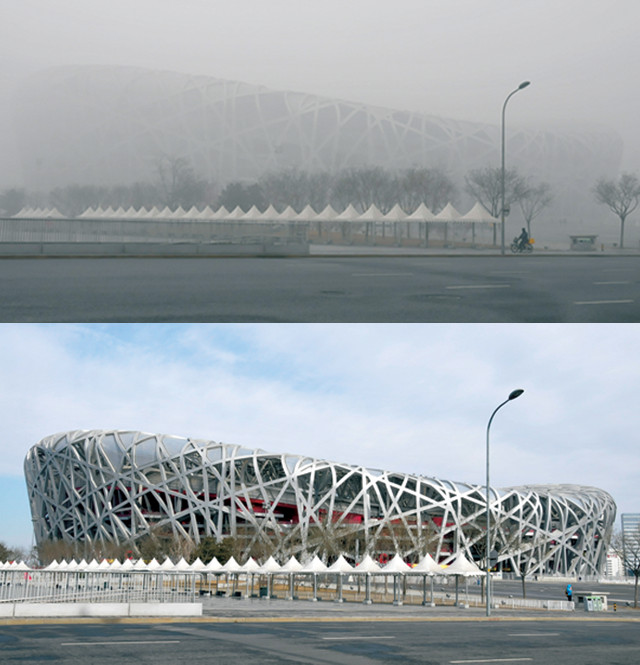
by Timothy Oleson Monday, January 5, 2015

Taken one day apart — on Jan. 31 (top) and Feb. 1, 2013 (bottom) — these photos of Beijing's National Stadium hint at the scale of China's pollution problem. Credit: both: Ru-Jin Huang and Jun-Ji Cao.
Images of Chinese skylines and streetscapes blurred by pollution-fueled hazes have become increasingly common in recent years amid ongoing urbanization and industrialization. According to a new study published in Nature, much of the pollution fogging the country’s major cities is arising not from fine particles emitted directly into the sky, but by gases that react and condense in the atmosphere to form secondary aerosols.
January 2013 was particularly bad for pollution, with air-quality measurements across dozens of Chinese cities revealing levels of fine particulates — that is, particles less than 2.5 micrometers in diameter, collectively known as PM2.5 — that exceeded national standards on 69 percent of days that month.
To better understand the makeup and sources of the haze, scientists collected daily air samples through January in four geographically distant cities: Beijing, Guangzhou, Shanghai and Xi’an. In the first three cities, secondary aerosols accounted for more than half — between 51 and 77 percent on average — of fine particulate pollutants. In Xi’an, the contribution of secondary aerosols was about 30 percent, although the city had far higher levels of particulate pollution overall due to high levels of airborne dust. The leading sources of the secondary aerosols — which form largely from precursor volatile organic compounds and inorganic sulfur and nitrogen gases — were traffic, coal and biomass burning, and cooking, all of which also directly emit large amounts of primary aerosols.
The study “suggests that emission control strategies to mitigate PM2.5 pollution in China should, in addition to primary particulate emissions, also address the emission reduction of secondary aerosol precursors,” Ru-Jin Huang of Switzerland’s Paul Scherrer Institute and colleagues wrote.
© 2008-2021. All rights reserved. Any copying, redistribution or retransmission of any of the contents of this service without the expressed written permission of the American Geosciences Institute is expressly prohibited. Click here for all copyright requests.